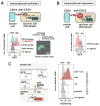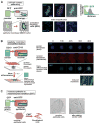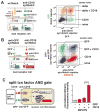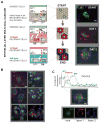Engineering Customized Cell Sensing and Response Behaviors Using Synthetic Notch Receptors
- PMID: 26830878
- PMCID: PMC4752866
- DOI: 10.1016/j.cell.2016.01.012
Engineering Customized Cell Sensing and Response Behaviors Using Synthetic Notch Receptors
Abstract
The Notch protein is one of the most mechanistically direct transmembrane receptors-the intracellular domain contains a transcriptional regulator that is released from the membrane when engagement of the cognate extracellular ligand induces intramembrane proteolysis. We find that chimeric forms of Notch, in which both the extracellular sensor module and the intracellular transcriptional module are replaced with heterologous protein domains, can serve as a general platform for generating novel cell-cell contact signaling pathways. Synthetic Notch (synNotch) pathways can drive user-defined functional responses in diverse mammalian cell types. Because individual synNotch pathways do not share common signaling intermediates, the pathways are functionally orthogonal. Thus, multiple synNotch receptors can be used in the same cell to achieve combinatorial integration of environmental cues, including Boolean response programs, multi-cellular signaling cascades, and self-organized cellular patterns. SynNotch receptors provide extraordinary flexibility in engineering cells with customized sensing/response behaviors to user-specified extracellular cues.
Copyright © 2016 Elsevier Inc. All rights reserved.
Figures







Comment in
-
A Receptor for All Occasions.Cell. 2016 Feb 11;164(4):599-600. doi: 10.1016/j.cell.2016.01.030. Cell. 2016. PMID: 26871625
-
Combinatorial Antigen Targeting: Ideal T-Cell Sensing and Anti-Tumor Response.Trends Mol Med. 2016 Apr;22(4):271-273. doi: 10.1016/j.molmed.2016.02.009. Epub 2016 Mar 10. Trends Mol Med. 2016. PMID: 26971630 Free PMC article.
-
SYNTHETIC BIOLOGY. Customizing cell-cell communication.Nat Methods. 2016 Apr;13(4):285. doi: 10.1038/nmeth.3824. Nat Methods. 2016. PMID: 27482567 No abstract available.
References
-
- Artavanis-Tsakonas S, Rand MD, Lake RJ. Notch signaling: cell fate control and signal integration in development. Science. 1999;284:770–776. - PubMed
-
- Blume-Jensen P, Hunter T. Oncogenic kinase signalling. Nature. 2001;411:355–365. - PubMed
-
- Cano A, Pérez-Moreno MA, Rodrigo I, Locascio A, Blanco MJ, del Barrio MG, Portillo F, Nieto MA. The transcription factor Snail controls epithelial–mesenchymal transitions by repressing E-cadherin expression. Nature Cell Biology. 2000;2:76–83. - PubMed
Publication types
MeSH terms
Substances
Grants and funding
LinkOut - more resources
Full Text Sources
Other Literature Sources
Research Materials

